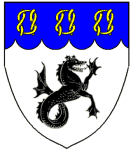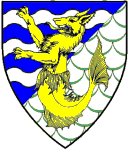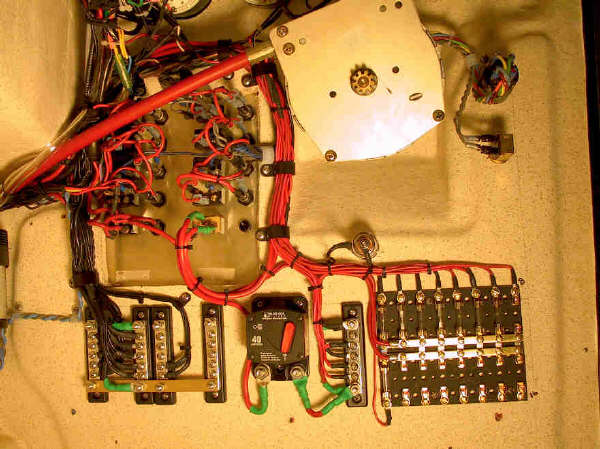| View previous topic :: View next topic |
| Author |
Message |
Big dave
Joined: 20 Aug 2005
Posts: 264
City/Region: Vancouver
State or Province: WA
C-Dory Year: 2006
C-Dory Model: 22 Cruiser
Vessel Name: Raven Dancer
Photos: Raven Dancer
|
 Posted: Mon Apr 10, 2006 11:27 pm Post subject: BATTERY SWITCH Posted: Mon Apr 10, 2006 11:27 pm Post subject: BATTERY SWITCH |
 |
|
Like many of you I have a four position battery switch on my boat, #1 position is for the starting battery, #2 position is for the deep cycle "house" battery and the "OFF" position, and "ALL" position.
Color me dumb but I don't know what the purpose of the switch is.
When I picked the boat up the switch was in the "ALL" position.
The other day I was messing about and moved it to the #2 position (house) everything works fine and I can also start the boat with it in the two position. I'm thinking Hmm I thought that position was for the house only so I move the switch to the one position, well the lights and all the electrical works and the boat starts, I'm thinking Hmm I didn't expect the lights and other electric things to work, so I crank the switch over to "OFF" and nothing works except the Wallace and the bilge pump, I'm thinking Hmm thats a good thing and just turn the switch back to "ALL" position, and I'm thinking if it ain't broke don't attempt to fix it !
So from what I have described does it sound like the switch is doing what it is supposed to do ? Should I just leave it in the "ALL" position ?  Thanks for any answers.....Big Dave. Thanks for any answers.....Big Dave. |
|
| Back to top |
|
 |
Sea Wolf
Joined: 01 Nov 2003
Posts: 8650
City/Region: Redding
State or Province: CA
C-Dory Year: 1987
C-Dory Model: 22 Cruiser
Vessel Name: Sea Wolf
Photos: Sea Wolf
|
 Posted: Tue Apr 11, 2006 2:02 am Post subject: Posted: Tue Apr 11, 2006 2:02 am Post subject: |
 |
|
Dave-
Here's a set of short answers to your questions:
The switch is designed to allow you to use the two batteries individually or in combination, as well as protect the whole boat by shutting off the power when not in use.
The system allows you to isolate the two batteries for their two different functions. The whole scheme is to try to isolate the house load on that battery so that you don't run the starting battery down and not have it when you need to start the engine.
When starting the motor, set the switch to #1 (starting battery).
When running the boat, after you have run the boat long enough to recharge the starting battery, switch to Both, and the alternator will charge both batteries.
When resting at the dock or at anchor, turn the switch to #2 (house battery). This allows you to use the house battery without running down the starting battery.
If for some reason you find that the starting battery will not start the motor by itself, you can switch to Both, and the house battery will assist the starting battery.
You'll also notice that when the switch is in the Both position, not only can you start the engine with both batteries, but in that position both batteries can be used to run the house functions. This is nice, but it doesn't protect the starting battery from being run down by the house load, so do not use the both position for the house load. If the house battery will not run the house load, start the engine with the starting battery, then recharge the house battery.
Actually, yours and most all systems wired a little differently so that both the house and the starting loads are off one terminal and the switch provides a choice of which battery (or both) will feed into that terminal.
Thus the starting battery will not only start the engine but also run the house load at the same time, and likewise the house battery will also both start the engine and run the house load. Or you can put the switch in the Both position, and both batteries will work together to run both loads. This is the way most all of the simple dual battery systems work. It's OK. You can still use the switch to determine which battery to put the load on, pretty much as intended above.
A few electrical devices are wired directly to one or the other of the batteries. The bilge pump is wired directly so you can't turn it off and it will therefore protect the boat from sinking at dock or anchor. The Wallas stove needs full voltage to start and run properly, and is therefore not wired through the battery switch.
Hope this simplified review answers your questions. If not, just ask!
Joe.
_________________
Sea Wolf, C-Brat #31
Lake Shasta, California
  
"Most of my money I spent on boats and women. The rest I squandered'. " -Annonymous |
|
| Back to top |
|
 |
terraplane
Joined: 09 Dec 2004
Posts: 524
City/Region: chesapeake bay
C-Dory Year: 2005
C-Dory Model: R-25 Tug
Vessel Name: BANJO
Photos: Sally's Sister
|
 Posted: Tue Apr 11, 2006 6:04 am Post subject: battery switch Posted: Tue Apr 11, 2006 6:04 am Post subject: battery switch |
 |
|
Joe,
That was the clearest and most concise explanation of the function of the battery switch on a c dory that i have seen. thanks.
tom terraplane |
|
| Back to top |
|
 |
Captains Cat
Joined: 03 Nov 2003
Posts: 7313
City/Region: Cod Creek>Potomac River>Chesapeake Bay
State or Province: VA
C-Dory Year: 2005
C-Dory Model: 22 Cruiser
Vessel Name: Captain's Choice II
Photos: Captain's Cat
|
 Posted: Tue Apr 11, 2006 8:40 am Post subject: Posted: Tue Apr 11, 2006 8:40 am Post subject: |
 |
|
Joe Said:
"When running the boat, after you have run the boat long enough to recharge the starting battery, switch to Both, and the alternator will charge both batteries. " as a part of a great explanation.
I have heard that there are two types of switches though and have seen both for sale, one that switches freely and one that "shorts" the connections as it is being switched. If you have one of the latter, there is some danger in switching when running as you could cause a momentary short. Joe can you elaborate?
Charlie
_________________
CHARLIE and PENNY CBRAT #100
Captain's Cat II 2005 22 Cruiser
Thataway (2006 TC255 - Sold Aug 2013)
Captain's Cat (2006 TC255 - Sold January 2012)
Captain's Kitten (1995 CD 16 Angler- Sold June 2010)
Captain's Choice (1994 CD 22 Cruiser- Sold Jun 2007)
Potomac River/Chesapeake Bay
K4KBA |
|
| Back to top |
|
 |
Sneaks
Joined: 06 Jun 2004
Posts: 2020
City/Region: San Diego (Encinitas)
State or Province: CA
C-Dory Year: 1993
C-Dory Model: 16 Angler
Vessel Name: C-Brat
Photos: Jenny B and C-Brat
|
 Posted: Tue Apr 11, 2006 10:36 am Post subject: Posted: Tue Apr 11, 2006 10:36 am Post subject: |
 |
|
I wish the durn switch manufacturers would label whether their switch is a "make before break" or not. Makes no diff, I always shut the engine down before switching anyway.
All this starting battery house battery talk makes sense in the RV world, but with 40-90 hp C-22 outboards? 'Splain please, Joe. My AGM's do just fine in either capacity.
Don |
|
| Back to top |
|
 |
CAVU
Joined: 02 Nov 2003
Posts: 665
City/Region: Spokane
State or Province: WA
C-Dory Year: 2002
C-Dory Model: 22 Cruiser
Vessel Name: CAVU
Photos: CAVU
|
 Posted: Tue Apr 11, 2006 11:34 am Post subject: Posted: Tue Apr 11, 2006 11:34 am Post subject: |
 |
|
Joe,
I thought the Wallas was wired directly to the battery to prevent shutting it down before it went through its lengthy cooling shutdown cycle. I wouldn't think the battery switch would cause any voltage drop?
_________________
Ken Trease
22 CD Cruiser, CAVU
Twin 40HP Hondas |
|
| Back to top |
|
 |
stevej
Joined: 01 Nov 2003
Posts: 314
City/Region: Gaston
State or Province: OR
C-Dory Year: 1995
C-Dory Model: 25 Cruise Ship
Vessel Name: Shearwater
Photos: Shearwater
|
 Posted: Tue Apr 11, 2006 11:38 am Post subject: Posted: Tue Apr 11, 2006 11:38 am Post subject: |
 |
|
Don as far as I know there is not a switch available for outboards that will allow you to switch between positions with the motor running. Or maybe I should say there are switches available but outboard charging systems do not have a separate alternator field wire that can be used for a alternator field disconnect if the switch supports it. What allows you to switch with the motor running is not a make before break function but the ability to cut power to the field windings prior to switching.
So unless you want to blow your alternator diodes NEVER switch between positions with the motor running.
If anyone knows of a switch that will work with an outboard charging system and allow switching with the motor running I would love to hear about it.
Shearwater is wired a little different than most boats with a 50 amp toggle switch in the dash that lets me select which battery will be the “house” battery. The big four way switch is used to direct charge path/start path or join both batteries together.
stevej
_________________
1995 25' Cruise Ship #3 |
|
| Back to top |
|
 |
Sea Wolf
Joined: 01 Nov 2003
Posts: 8650
City/Region: Redding
State or Province: CA
C-Dory Year: 1987
C-Dory Model: 22 Cruiser
Vessel Name: Sea Wolf
Photos: Sea Wolf
|
 Posted: Tue Apr 11, 2006 12:09 pm Post subject: Posted: Tue Apr 11, 2006 12:09 pm Post subject: |
 |
|
Charlie and Don-
Thanks for the morning headache!!!
Actually, it kinda fun, but dealing with this electrical stuff can get so iffy and contingent and the possibilities of making a statement that can be shown to be wrong under certain circumstances are so great as to intimidate one from writing too much, less the writer fall off the plank into the sea of sharks of amatuer and professional Electrical Engineers!
Nonetheless, throwing caution to the wind, we'll set sail on this perilous journey to the la-la land of electrical lumination. (The secret will be to keep it simple so as to not say much of anything too specific as to require a lot of qualification or explanation.)
There are twp basic types of battery switches that your question is about.
One goes from (O-)1-B-2 while breaking contact between the terminals, which momentarily disconnects one battery from the engine and alternator berfore connecting the next.
The second is a "make before break" switch type that has switch contacts that touch the next battery contacts before leaving the last.
So why the difference?
If you switch off the battery load suddently on an alternator, bad things happen to the diodes in the alternator.
During operation, the voltage regulator has already sensed the voltage of the battery and sent an adjusted load to the rotor of the alternator which spins the electromagnetic field that generates current in the outside or stator windings of the alternator. Diodes imbedded in the alternator body change the AC current induced in the stator windings into DC current which is applied to the battery, charging it.
Breaking contact between the battery and the alternator suddenly unloads the system, and the sudden unloading overloads the diodes with electrical pressure that they cannot handle, and they are destroyed by the sudden surge of current with no place to go but through them destructively.
This danger from sudden unloading is why they developed the "make before break" type switches. The outboards, at least, don't seem to mind being switched from one battery to the next with this type of switch. I'd do it at low rpm, though, in case there's a big difference in the condition of the two batteries (and therefore load on the alternator).
It is also why some people still don't switch battery positions until turnhing the engine off, following the old "don't switch battery positions while the engine is running" dictum.
Some more sophisticated types of battery switches have a "Alternator Field Disconnect" set up with separate contacts through which the alternator field (rotor) current flow from the voltage regulator is cut off to unload the alternator when switching battery connections. These are used on inboards only, to my knowledge, where the charging circuitry is exposed, unlike an outboard.
************************************************************
I'll tackle the battery type question in a minute- got to do some heavy duty dog sitting in rainy weather just now!
Joe.
Last edited by Sea Wolf on Tue Apr 11, 2006 2:07 pm; edited 2 times in total |
|
| Back to top |
|
 |
Sea Wolf
Joined: 01 Nov 2003
Posts: 8650
City/Region: Redding
State or Province: CA
C-Dory Year: 1987
C-Dory Model: 22 Cruiser
Vessel Name: Sea Wolf
Photos: Sea Wolf
|
 Posted: Tue Apr 11, 2006 12:36 pm Post subject: Posted: Tue Apr 11, 2006 12:36 pm Post subject: |
 |
|
Don-
A don't see any real need for AGM or gel-cell batteries as I've described before, as the loads on the house and engine are moderate enough to go with deep cycle batteries which provide plenty of starting amperage. Those batteries do provide some advantages in race cars, airplanes, and the like, but who's upside down in their C-Dory regularly? KISS says inexpensive but high quality deep cycles bought at discount stores and properly housed and cared for are the simple way to go. Those more sophisticated batteries also require special charging cylces and therefore chargers.
Steve-
Apparently it is not absolutely necessary to disconnect the alternator field circuit when switching batteries with a make before break battery switch. I know of lots of folks who do it, including myself occasionally. One of the protecting factors here is probably that most folks turn the engine down to idle speeds before going back to the switch to do the deed! In practice, it seems OK!
Ken- You're right about the cool down cycle with the Wallas. I'd forgotten that!! (I'm running propane in a Force 10 Cozy Cabin Heater and a 120 v electric heater off of a Honda generator, so don't have to deal with the Wallas.)
Thanks, guys!
Joe. |
|
| Back to top |
|
 |
flapbreaker
Joined: 26 Jan 2005
Posts: 878
City/Region: Hillsboro
State or Province: OR
C-Dory Year: 2006
C-Dory Model: 22 Cruiser
Vessel Name: Playin' Hooky
Photos: Playin' Hooky
|
 Posted: Tue Apr 11, 2006 2:39 pm Post subject: Posted: Tue Apr 11, 2006 2:39 pm Post subject: |
 |
|
I have one of these that handle the charging. It automatically switches between the starter battery and house battery while running so I am not so sure it's bad on the altanator diode but I'm no expert.

http://www.bepmarine.com/showproduct.cfm?productid=12 |
|
| Back to top |
|
 |
Sneaks
Joined: 06 Jun 2004
Posts: 2020
City/Region: San Diego (Encinitas)
State or Province: CA
C-Dory Year: 1993
C-Dory Model: 16 Angler
Vessel Name: C-Brat
Photos: Jenny B and C-Brat
|
 Posted: Tue Apr 11, 2006 5:05 pm Post subject: Posted: Tue Apr 11, 2006 5:05 pm Post subject: |
 |
|
| Sea Wolf wrote: | Don-
A don't see any real need for AGM or gel-cell batteries as I've described before, as the loads on the house and engine are moderate enough to go with deep cycle batteries which provide plenty of starting amperage. Those batteries do provide some advantages in race cars, airplanes, and the like, but who's upside down in their C-Dory regularly? KISS says inexpensive but high quality deep cycles bought at discount stores and properly housed and cared for are the simple way to go. Those more sophisticated batteries also require special charging cylces and therefore chargers.Joe. |
A see y'all are in Southern Lake Shasta, Joe. I consider AGM batteries absolutely necessary for my personal boat. Like white shirts attract spaghetti sauce, my clothes attract battery acid. Always have. On the USS Sailfish, all I had to do was open the battery access hatch to ruin a set of dungarees.
Get whatcha want, I'd rather spend on a better charger than hear spousal unit gripe when she takes my clothes outta the dryer and they look like they were shot with a load of birdshot....
Which takes me back to wishing the doggone switch guys would label the switch action clearly. 
Don
_________________
Mary & Don Anderson
Brat #483
"Jenny B" 2005 C-22/F75 sold, Oct. 2008
"C-Brat" 1993 C-16 angler/50 hp |
|
| Back to top |
|
 |
Sea Wolf
Joined: 01 Nov 2003
Posts: 8650
City/Region: Redding
State or Province: CA
C-Dory Year: 1987
C-Dory Model: 22 Cruiser
Vessel Name: Sea Wolf
Photos: Sea Wolf
|
 Posted: Tue Apr 11, 2006 5:36 pm Post subject: Posted: Tue Apr 11, 2006 5:36 pm Post subject: |
 |
|
flapbbreaker-
Well, I'm no expert, either, really, but this looks like a really nice device providing the boat is wired correctly for it, something that should best be done when the boat is new. Wired into the boat by the factory, it should give you a lot of service and is, most undoubtably, correctly employed.
There are a lot of nice, new, similar devices that can be incorporated into the boat's circuitry when it's new, or, can be added later, if you're willing to rewire a little or a lot, depending on the modifications required.
Blue Sea Systems and others like BEP make some reallly slick new stuff that should be a lot of fun for the electrical system designer.
However, for the consumer, some of the new goodies present new challenges of trying to understand what's going on the new circuitry for those used to traditional wiring solutions.
We had a thread recently where some similar type of device was used on a dual engine application, and at least for awhile, presented an enigma for the owner and others to understand and subsequently deal with the electrical problem involved.
I think it would be fun to tear out all the wiring in a boat and rewire it from scratch, as several have done here, including Stevej of Sherwater, and Mark of 3rd Byte. However, it's an awful lot of work since it must be done in very confined spaces, and, unfortunately, in my case, Mr. Arthritis says NO!

Steve rewire project!
In my own case, it was simpler to add a couple of extra batteries and go with the "Tim the Toolman" type of solution where more power was the easy answer!
Joe.
Last edited by Sea Wolf on Tue Apr 11, 2006 5:54 pm; edited 1 time in total |
|
| Back to top |
|
 |
Sea Wolf
Joined: 01 Nov 2003
Posts: 8650
City/Region: Redding
State or Province: CA
C-Dory Year: 1987
C-Dory Model: 22 Cruiser
Vessel Name: Sea Wolf
Photos: Sea Wolf
|
 Posted: Tue Apr 11, 2006 5:51 pm Post subject: Posted: Tue Apr 11, 2006 5:51 pm Post subject: |
 |
|
Don-
Never had any battery acid problems on a boat, except for one that blew up and boiled in the middle of De Valle Lake in the Bay Area after being overcharged a bit. (You don't want this to happen to you-keep the battery in a box with the lid on tight for sure!)
So what you're saying is that, in a few more years, when I get old enough to be forced into wearing a hearing aid to still be in any contact at all with the outside world, I'll have to forego using a lead-acid battery for the battery I'll be sticking in my ear?
Damn! And I had an old, cheapo, 27F just set aside for that!
Joe. |
|
| Back to top |
|
 |
Sneaks
Joined: 06 Jun 2004
Posts: 2020
City/Region: San Diego (Encinitas)
State or Province: CA
C-Dory Year: 1993
C-Dory Model: 16 Angler
Vessel Name: C-Brat
Photos: Jenny B and C-Brat
|
 Posted: Tue Apr 11, 2006 6:44 pm Post subject: Posted: Tue Apr 11, 2006 6:44 pm Post subject: |
 |
|
| Sea Wolf wrote: | Don-
So what you're saying is that, in a few more years, when I get old enough to be forced into wearing a hearing aid to still be in any contact at all with the outside world, I'll have to forego using a lead-acid battery for the battery I'll be sticking in my ear? |
Not to worry, Joe. I'll tell you to stick it in your ear long before that time.
 |
|
| Back to top |
|
 |
oldgrowth
Joined: 27 Jun 2005
Posts: 2196
City/Region: Rochester
State or Province: WA
C-Dory Year: 2002
C-Dory Model: 16 Cruiser
Vessel Name: C-Voyager
Photos: C-Voyager
|
 Posted: Tue Apr 11, 2006 7:06 pm Post subject: Posted: Tue Apr 11, 2006 7:06 pm Post subject: |
 |
|
I am one of those that rewired my boat from scratch. I used a BlueSea Battery Link ACR (automatic current regulator) to automatically combine my house and start battery, when the house battery needs charging. I also placed a single ON/OFF Switch across the positive fields of the ACR so I could manually combine the batteries. I then placed an indicator light on my dash, that lights up when the batteries are combined. This will remind me that the batteries are combined, in case I forget. I have photos of it in my Boat Projects Album.
You can click on the photo for more information about the ACR on BlueSea's site. I am satisfied with it. It has worked for me.

_________________
Dave 
Last edited by oldgrowth on Wed Mar 05, 2008 4:29 am; edited 1 time in total |
|
| Back to top |
|
 |
|
|
You cannot post new topics in this forum
You cannot reply to topics in this forum
You cannot edit your posts in this forum
You cannot delete your posts in this forum
You cannot vote in polls in this forum
You cannot attach files in this forum
You cannot download files in this forum
|
|

 Search
Search Private Messages
Private Messages Profile
Profile Log in
Log in Register
Register Help
Help









